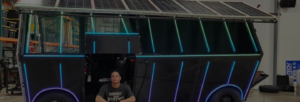Off-Grid Power – Air Conditioners Solar power and lithium battery technology have revolutionized the way...
Read MoreWhat inverter do I need to run a microwave?
For RVers and boondockers, microwaves and other off-grid appliances provide many creature comforts of home. Choosing the right inverter will ensure your microwave runs optimally, protect your batteries from damage, and extend the lives of your other appliances.
Before selecting your inverter, it’s important to learn a few electricity basics. In this article we will cover items like understand how appliances start up and cycle, and how solar works in your RV’s electrical system, so you know how much power your microwave is using and if you have enough battery power to handle it.
While it can be confusing at first, once you have the basics down, you’ll be heating up dinner in your RV microwave in no time!
What is an Inverter?
Starting at the beginning: what exactly does an inverter do? Inverters are designed to take direct current (DC) power (e.g., power from a battery or solar panels) and convert it to alternating current (AC) power used by appliances. AC power is what comes from the wall sockets in your home, while DC power is used for battery-operated toys and devices. In order to utilize the outlets in your RV or travel trailer, you need to have an inverter. Click here for more sizing information.
Appliance Ratings Don’t Give You the Whole Story
It may seem straightforward to read the appliance label and think, “that’s how much power I need,’’ — but that’s misleading. Almost all appliances use more power than what they are rated for. That extra starting power, in effect, is what gets them moving.
The larger the appliance, the more power they’ll use at start-up. Air conditioners, refrigerators, and even microwaves can use as much as 3x their rated power when starting up.
A Short Math Lesson
This start-up requirement means that your 900-watt microwave may draw 2,700 watts of power at start-up. The surge will only happen for a millisecond, and then your appliance quickly moves to ‘running watts’ — the wattage rating on the label.
When choosing an inverter, you need one that can accommodate the start-up draw.
When choosing an inverter, you need one that can accommodate the start-up draw. A 2,000-watt (running watts) inverter may have a peak (or surge) output of 3000 watts. This inverter could easily handle both the 900 running watt and the 2,700-watt surge (starting draw) requirements of your microwave.
So, you’ve chosen the correct size of inverter. But there’s another factor to consider.
Pure Sine Inverters — Why Do They Work Best for Appliances?
There are two types of inverters — pure sine wave and modified sine wave.
Pure sine inverters provide high-quality power that closely matches that found in your home. Modified sine inverters are a more affordable option, and use a basic form of technology that supplies power in a more erratic fashion, with more peaks and ebbs in the flow.
Many modern appliances (including microwaves) are susceptible to power fluctuations and operate sub-optimally with power from a modified sine inverter. Opting for a pure sine inverter ensures you always get the best performance and life expectancy from your appliances.
How Do I Size My Battery Bank?
Your inverter is only one piece of the power puzzle. You might have a high-performance pure sine inverter, but without the right size battery bank, your inverter won’t work correctly — or may even shut off.
Batteries store energy in DC form. The inverter draws power from the batteries and converts it to usable, AC energy. When the inverter begins to draw power from the battery, the battery’s voltage drops noticeably, then begins to recover. This recovery occurs when the liquid electrolyte inside the battery starts to mix and contacts the plates inside the battery cells.
Many battery variables can cause your inverter to go into fault, cut-off, or even shut down completely. These include a battery that’s too small, poor battery health, cold temperatures, or an extreme load surge at appliance start-up that causes a significant load drop.
Simply put, the appliance won’t start because the initial draw at start-up is more than the battery can handle.
Bringing in Solar to Help Your Batteries Run Your Microwave (A Little More Math…)
Let’s chat about determining if your system has the power and your batteries have the amperage to run your microwave (and for how long). We now know that having enough power to start it up is one thing, but do you have enough amps stored in your batteries to meet the needs of the microwave to run for a full five minutes? Here’s how you can determine your battery needs…
Assuming perfect inverter efficiency (which is often not the case), a 1200-watt inverter running for five minutes will use 100 watt-hours of energy from the battery bank. However, the microwave’s start-up load on a battery bank would be approximately 56 amps for 90% inverter efficiency.
Amps x Volts = Watts
You can also determine amps by dividing watts by volts for the amp value. If your microwave needs 56 amps at start-up, even with the right sized inverter, you’ll require multiple batteries to avoid damaging batteries or causing your inverter to fault and shut off.
Using our Overlander kit as an example, there are roughly 9 amps of power collected per solar panel, per hour if there is at least 6 hours of sun per day. In other words, that panel will put roughly 54 amps of power back into your battery bank per day (or per 6 hours of sunlight).
Using this math, it will take your panel an hour of mid-day sun to fire that microwave up in the first few seconds. This is why we recommend having multiple batteries.
Your Microwave Matters
Finally, the type of microwave you want to use in your RV matters. Is your microwave the one that came pre-installed by your RV manufacturer? Or is it one you brought from home? OEM installed microwaves are usually smaller and use less power than their homeward-bound counterparts. Our experts recommend a 1500-watt pure since-wave inverter if you are planning to use the one that came in your RV, and a 2000–watt pure since wave inverter to run a conventional countertop microwave.
Consult with the Experts
As you can see, there are quite a few things to consider when determining the correct number of batteries, you’ll need to run your microwave — plus any other systems that may be drawing from your batteries at the same time.
While choosing the right inverter to operate your microwave and other appliances is essential, it’s just one step in building a safe, efficient power system for your RV.
LATEST NEWS
Watch product troubleshooting videos, read the latest in company updates, and stay up-to-date on trade-shows and events.
Creating the Ultimate Solar-Powered Car
Few people have a more diversified portfolio when it comes to custom car builds than...
Read MoreGo Power! Wins Gold in
Go Power! Wins Gold for Favorite RV Solar Product in the 2024 Wildsam Reader’s Choice...
Read More
STAY UP TO DATE
Get news, product specials, and event invites directly to your inbox.







